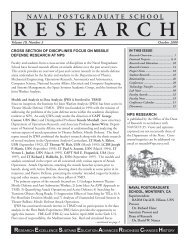Spectral Unmixing Applied to Desert Soils for the - Naval ...
Spectral Unmixing Applied to Desert Soils for the - Naval ...
Spectral Unmixing Applied to Desert Soils for the - Naval ...
Create successful ePaper yourself
Turn your PDF publications into a flip-book with our unique Google optimized e-Paper software.
After data have been converted <strong>to</strong> reflectance, <strong>the</strong>y must <strong>the</strong>n be<br />
atmospherically corrected <strong>to</strong> account <strong>for</strong> interactions with <strong>the</strong> atmosphere such as<br />
scattering and absorption by atmospheric gas and particulate material (Kruse et al., 2000).<br />
Atmospheric correction is a necessary step that allows <strong>for</strong> determining physical aspects of<br />
imaged materials and making inferences with <strong>the</strong> data during analysis (Kruse et al.,<br />
2000).<br />
c. Analysis Using Continuum Removal<br />
A continuum can be thought of as a ma<strong>the</strong>matical means by which you<br />
can isolate a particular absorption feature of a spectrum and is related <strong>to</strong> <strong>the</strong> electronic<br />
and vibrational processes that occur within surface materials discussed earlier (Clark and<br />
Roush, 1984). The purpose of continuum removal is <strong>to</strong> rid <strong>the</strong> spectrum being analyzed<br />
of affects from o<strong>the</strong>r processes within <strong>the</strong> material or o<strong>the</strong>r materials in a mixture so<br />
characteristics of an individual feature can be better examined (Clark and Roush, 1984;<br />
Clark, 1999; Clark et al., 2003; Kruse, 2008). The continuum removal is done by<br />
estimating <strong>the</strong> o<strong>the</strong>r absorption processes using functions such as, but not limited <strong>to</strong><br />
Gaussians and straight-line segments (Clark and Roush, 1984). The ma<strong>the</strong>matical<br />
function <strong>for</strong> continuum removal, according <strong>to</strong> Clark and Roush (1984) is expressed as:<br />
r( )<br />
e e e<br />
where:<br />
( k1l1) ( k2<br />
l2)<br />
( kl<br />
3 3 )<br />
(3)<br />
r is reflectance,<br />
k1, l 1 are functions of <strong>the</strong> wavelength and represent absorption of some process of<br />
interest in <strong>the</strong> material,<br />
k2, l 2 are absorption related <strong>to</strong> o<strong>the</strong>r processes in <strong>the</strong> mineral,<br />
k3, l 3 are absorption related <strong>to</strong> o<strong>the</strong>r processes from o<strong>the</strong>r materials.<br />
Continuum removal during spectral analysis is useful in both biological and<br />
mineralogical analysis. This method has been found <strong>to</strong> be successful in correlation of<br />
11
















